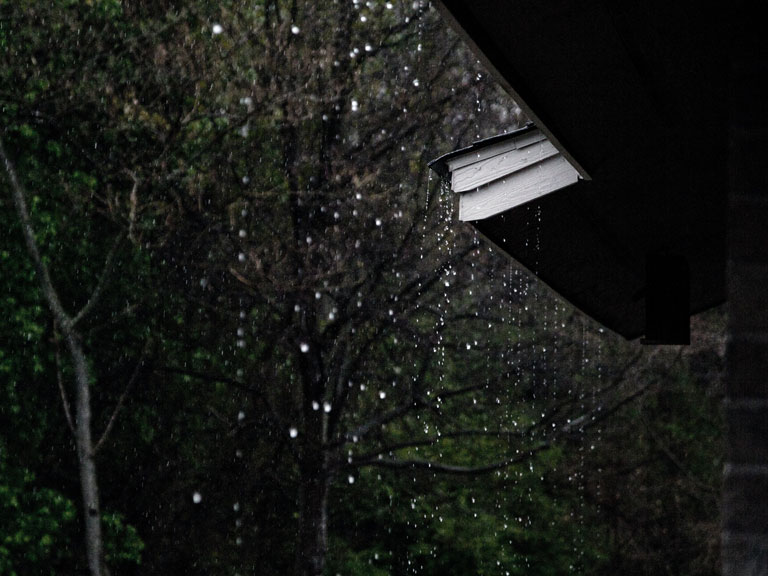January 26, 2021
Detecting Storm Damage On Your Roof

Your home is a protective barrier against the elements when a storm passes through the area. Most structural materials can take on mild to moderate storms, but extreme rain and wind can break down certain areas. Your roof can become a victim of storm damage, and it can be difficult to know when it’s time to call in the professionals. Take a look at how you can detect rooftop damages before the next storm arrives.
1. Missing Materials
Take a casual glance at your rooftop from the ground. If you notice any shingles missing from the surface, it’s time to call our roof repair company. Missing shingles are a telltale sign that extensive damage is part of your structure. Moisture can quickly find its way into the home through these pathways. Further damage to the home is possible if they aren’t replaced.
Our team at KNS Remodeling can tell you if a patch job or full replacement is necessary. You definitely want the professionals working on this repair for safety reasons.
2. Crease Marks
Both nails and adhesive connect your shingles to the home below. During a storm, wind gusts might lift part of the tabs upward. They can drop right back down into place, but the strain on the materials leaves its mark. You might see crease marks along the middle section of your shingles. Although they’re still attached, the marks’ presence can lead to these issues, such as:
- Leaks
- Broken Tabs
- Cracked sections
A roofing contractor should evaluate the creases and determine the best course of action. Replacing them is usually the safest solution.
3. Curling Edges
Storm damage can come in the form of curled edges on the shingles. Wind is usually the culprit for curled edges. Gusts that move up and over the roof can permanently bend the tab edges. Healthy shingles always appear flush against the roof’s surface.
Don’t allow the curled edges to remain in place. A roofing contractor must replace these shingles because moisture easily seeps under them. The curled shape cannot be nailed back down either; they’ll always need to be replaced so that the home is safe from leaks.
4. Dimpled Appearance
The National Storm Damage Center identifies bruises as a concerning problem on the rooftop. These marks are often accompanied by a dimpled appearance, which is caused by hail.
Hail comes in many shapes and sizes, and severe storms hold countless numbers of these icy balls. As they strike the roof, they leave their marks. They may even leave holes or cracks in the roof. This scenario is most common when the roof is nearing the end of its lifespan. A roofing contractor can make a determination between repairing and replacing a roof after a hailstorm. New shingles may be able to take on the hail more readily than weakened materials.
5. Staining Within Interior
Some damages aren’t even visible on the rooftop. Mysterious stains found within the interior will tell you if there’s a roofing problem. Take a look within your attic for any yellowing or stains on the walls or wood beams. There may not be any moisture in the area right now, but the stains indicate that there was a leak.
These leaks will return, so contact our staff for a thorough inspection. We can pinpoint the leaks’ entry points so that they can be repaired. There may even be multiple entry points, which must all be fixed for structural integrity.
6. Damaged Metal Fascia
Don’t overlook damages that might extend to the metal fascia, reports Angie’s List. These metal pieces line the transitions between the shingles, chimney and exhaust vents. Although they’re tough materials, they can loosen, bend and even break off from the roof.
Look for damage to the metal in these areas too, including:
- Valleys
- Wall connections
- Surrounding skylights
Our team will always inspect the shingles and their supportive materials. The metal fascia is just as important as the asphalt shingles when it comes to protecting the home.
7. Excessive Volume of Granules on Ground
A roof repair is in order when you notice debris on the ground. Asphalt shingles have rocky granules on their surfaces as pathways for water and protection against the elements. Small amounts of granules might litter the ground after a storm, which is entirely normal. If you see an excessive amount of granules, however, the shingles may be significantly declining.
Ask our team about an evaluation. Although the shingles may be perfectly attached, missing granules will allow water into the home over time. It’s a better course of action to consider patching or replacing the materials.
8. Loose Shingles
One of the most difficult damages to determine from a ground perspective is loose shingles. They might appear to be in good shape, but they’re merely laying on the roof without much of a connection. Allow KNS Remodeling to inspect the roof with a thorough walk across it. We can find those bad sections and possibly reattach them. In some cases, replacing the materials is necessary.
Don’t hesitate to call our professionals after a storm. Those loose shingles will continue to worsen and allow moisture into the home.
Contact us at KNS Remodeling for an estimate today. We’re proud to serve the Winston-Salem, High Point and Greensboro area. Allow us to verify your roof’s integrity and suggest any repairs. Storm damages can be repaired with the proper inspection, tools and experience offered by our team.
